Nuclear options: a teacher at CERN Inspire article
Physics teacher Günter Bachmann explains how his CERN residency has inspired both him and his students.
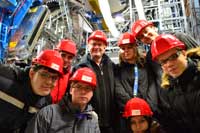
experiment at the LHC
Image courtesy of Yassin
Haijam
When Günter Bachmann, head teacher of a school in the German state of Saxony, enrolled on a one-week training course at CERN, the world’s largest particle physics laboratory (see box), he had high expectations of the course – but he wasn’t expecting to be asked back as a teacher in residence.
However, that’s exactly what happened. As a teacher of physics for some 30 years, Günter knew how to make the most of the opportunity, and now views it as the most exciting moment of his career so far.
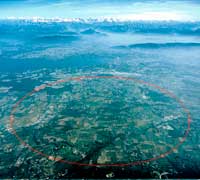
LHC marked in red
Image courtesy of CERN
“It’s widened my understanding of modern physics and international science management enormously,” he says. “It’s also given me the chance to interest students in new questions and developments.”
During his residency in 2011, Günter worked with Rolf Landua, the head of education at CERN, to develop a collection of teaching materials for students aged 14 to 16 on the topic of cosmic radiation. The resource was designed with clear ideas about what was needed: it should add “joy and interest” to the study of physics, and – as far as possible – avoid mathematical and specialist terminology.
Since then, Günter has been busy passing on the benefits of his experience to his students. “I’ve tested the materials with a class of students and received remarkably positive feedback – especially considering that this class is not among the highest achieving at the school,” he says. The material will soon be available on the CERN website, in both English and Germanw1.
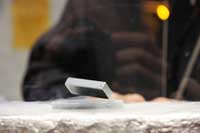
superconductivity
Image courtesy of Yassin
Haijam
His time at CERN also emphasised for Günter the importance of current research results being covered in the school physics curriculum, to show the true, open-ended nature of scientific enquiry. “The methods of working [at CERN], which were open to many different conclusions, were very unfamiliar to me, since they represent quite the opposite of the totally organised life at school,” he explains.
Initially, it took a while for Günter to settle in to life at CERN. “I had some problems in finding my way around the large CERN grounds, and also getting used to speaking English, which is the standard working language there,” he says. But this gave him another educational insight. “Students should be educated in both science subjects and the English language,” he argues. “One cannot work properly without the other.” He believes that learning English is a significant advantage for talented science students, as they will need it if they go on to study at an advanced level.
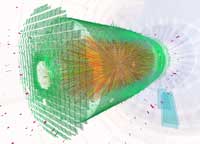
representation of the results
of particle collisions
Image courtesy of CERN
Günter now feels that such opportunities of practical training at research institutions (e.g. at CERN, see box; at other EIROforum institutions, see Furtado Neves, 2012; and at Science on Stage festivalsw2) should be available to more science teachers. He would also like to see more support given to physics teachers to help them keep up with developments in their subject. “As some time has passed since my graduation from university, I would like to see a course of lectures – perhaps online – about the discoveries and developments in physics during the past 40 years,” he says.
He firmly believes that modern physics should have a stronger presence in his classes – but this is easier said than done. “In Saxony, more than 90 % of the physics curriculum is predetermined. For the remaining 10 %, teachers must choose between set topics – which means they have very little chance to introduce their own ideas,” Günter says. He would especially like to see more coverage of particle physics, including the standard model – the established theory of fundamental forces and particles that was developed in the 1970s.
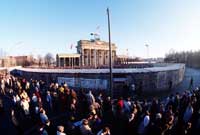
shortly before it was torn
down. The Brandenburg Gate
can be seen in the
background
Image courtesy of Ben-nb;
image source: Wikimedia
Commons
Günter himself graduated from the University of Leipzig, Germany, as a mathematics and physics teacher in 1980, and has worked in this capacity since then, initially in East Germany and since 1990 in the unified Germany. His love of science was inspired by activities at home in his early years, as he explains: “As a child, I often built wooden water wheels with my grandfather, and tested them on small creeks. Sometimes we used the water wheels to power small-scale wooden hammer mills. I think my interest in the forces of nature and how they can be used by people developed during that time.”
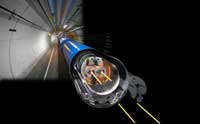
series of LHC magnets, used
to keep the particles on a
circular path through the
tunnel. CERN scientists are
interested in what happened
when two streams of
particles collide
Image courtesy of CERN
But his choice of physics was due not only to such inspirational experiences, but also to the political situation at the time. “I chose science as my field of study because, in former East Germany, I wanted to be able to teach subjects that were independent of any ideology or political propaganda,” he says.
Early in 2012, Günter returned to CERN with 20 of his keenest students, for a packed three-day programmew3. While there, the group constructed their own cloud chamber for detecting particles (see Barradas-Solas & Alameda-Meléndez, 2010) and analysed data from CERN’s giant particle accelerator, the Large Hadron Collider (LHC; see Landua & Rau, 2008, and Landua, 2008).
Now back at his school, what other changes would Günter like to see in physics teaching in his region? “There should be more freedom for teachers in designing the curriculum,” he says, “and an additional hour of physics each week would give sufficient time to reinforce fundamental knowledge and conduct experiments.” All good training for the aspiring scientists of Saxony.
More about CERN
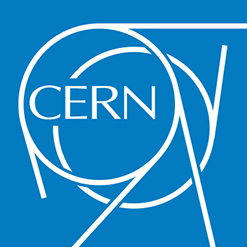
The European Organization for Nuclear Research (CERN)w4 is one of the world’s most prestigious research centres. Its main mission is fundamental physics – finding out what makes our Universe work, where it came from, and where it is going.
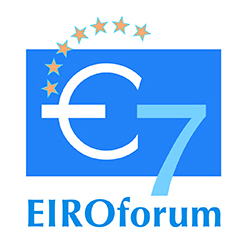
CERN’s mission also covers education. As part of its education activities, CERN offers courses for physics teachers in English or in their mother tongue, lasting between three days and three weeks. Participants experience the atmosphere of frontier research at the Large Hadron Collider, meet scientists and teaching colleagues, and find new ideas for bringing modern physics into the classroom.
CERN is a member of EIROforumw5, the publisher of Science in School.
References
- Barradas-Solas F, Alameda-Meléndez P (2010) Bringing particle physics to life: build your own cloud chamber. Science in School 14: 36-40.
- Furtado Neves S (2012) Diving into research at the EIROforum teacher school. Science in School 22.
- Landua, R (2008) The LHC: a look inside. Science in School 10: 34-45.
- Landua R, Rau M (2008) The LHC: a step closer to the Big Bang. Science in School 10: 26-33.
Web References
- w1 – The CERN website hosts the teaching materials that Günter developed (in both English and German).
- w2 – The Science on Stage international science teaching festivals offer participating teachers the chance not only to exchange inspiring teaching ideas, but also to attend lectures and presentations on cutting-edge scientific topics.
- The next festival, in April 2013, will take place in Słubice-Frankfurt (Oder) on the Polish-German border. Each country will be represented by a delegation of teachers selected in national events. Participation is free for the delegates. To be considered for your national delegation, contact your national organisers as soon as possible, because the selection events are already beginning in some countries. There will also be a limited number of places for non-delegates, who will be charged a registration fee.
Science on Stage was launched in 1999 by EIROforumw5, the publisher of Science in School.
- The next festival, in April 2013, will take place in Słubice-Frankfurt (Oder) on the Polish-German border. Each country will be represented by a delegation of teachers selected in national events. Participation is free for the delegates. To be considered for your national delegation, contact your national organisers as soon as possible, because the selection events are already beginning in some countries. There will also be a limited number of places for non-delegates, who will be charged a registration fee.
- w3 – The students’ report (in German) of their trip to CERN is available on the school website.
- w4 – To learn more about CERN, visit the CERN website.
- w5 – EIROforum is a collaboration between eight of Europe’s largest inter-governmental scientific research organisations, which combine their resources, facilities and expertise to support European science in reaching its full potential. As part of its education and outreach activities, EIROforum publishes Science in School.





